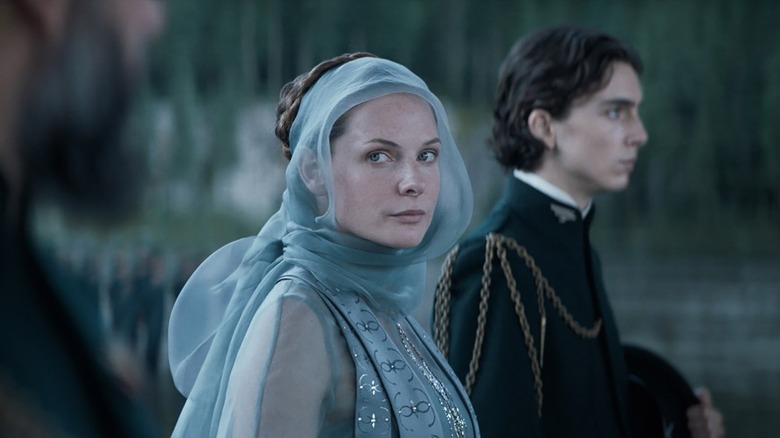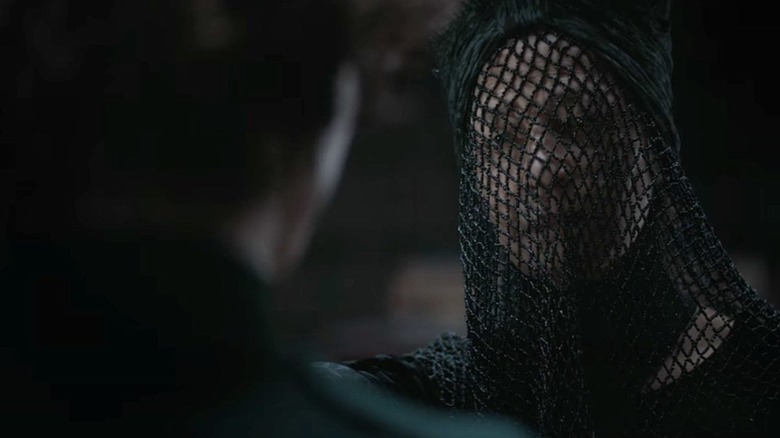Dune Co-Costume Designer Bob Morgan Goes Back In Time For The Future [Interview]
Bob Morgan gets chills just talking about "Dune." The costume designer, who worked with Jacqueline West on Denis Villeneuve's feature adaptation of the Frank Herbert sci-fi epic, was recounting watching 200 soldiers in the desert, dressed in the uniforms he helped create.
"It's one thing to have one person standing there, it's another thing to have 200 people standing there," Morgan recalled in an interview with /Film. "I remember the day we lined up the Harkonnen soldiers, for the first time in the uniform in the dark, wow. Now that's a wall or something."
Along with West, Morgan witnessed his work come to life on a grand scale. He had goosebumps watching it happen and, again, remembering such a stunning image.
For Morgan, no matter how many movies he's worked on, "Dune" was a dreamlike experience. Prior to his time on part one of "Dune," he worked on "Inception," "Man of Steel," and "Charlie Wilson's War" as the costume supervisor. Those titles barely scratch that surface of Morgan's career, though. Recently, the co-costume designer behind "Dune" talked to us about how he and West brought history to the costumes of a far-future sci-fi world.
"Step back a thousand years to go 10,000 years ahead."
You and Jacqueline had artists working all over the world on the movie. Where exactly?
We started in Los Angeles and we knew that we were going to go to Budapest and to Jordan. Obviously, you start at home, but you have three worlds you're creating. A lot of things are having to happen simultaneously, and at the time we started in 2018, it was in November. Again, like it is now, the world of film was a very busy place, which meant a lot of the artisans that we wanted to use were busy.
Luckily, I was able to secure a lot of artists that I've worked with on previous films and have a lot of them come to Budapest. But a lot of them work independently from us, in different locations. I took off for Budapest knowing we were going to build everything there. Logistically, it made sense to go there. Once we got there we realized we had three, four full-time shops. An armory die shop, a textile shop, an aging department, a sewing department, a prop department, all in Budapest studios.
We started making costumes in Spain. We made costumes in London. So I was going back and forth to London with our vendor. FDSS was incredible. We were kind of a traveling circus mostly across Europe. Not to mention, we had crew members coming from everywhere. From New Zealand, Australia, United States, Spain, Budapest, and England. We were a giant global family, just sailing upon Budapest.
What were some of your earliest ideas for "Dune"?
Early on, Denis was incredibly collaborative and so clear in his vision. He gave us a beautiful frame of what it was and what it wasn't. And then, we got this tremendous window for us to create within and explore everything between those two things. And so, as we set out, obviously the book was our starting point.
For the future, we had to kind of step back a thousand years to go 10,000 years ahead, knowing that these were human beings. This was an epic adventure of these three worlds, of these three families that were battling each other, and that's kind of how it started. Knowing that Caladan was very deep and rich and lush, knowing that Arrakis was very dry, knowing Harkonnens were oppressive and incredibly dire and dark, that was the first triangle of these three opposing worlds that were going to intersect.
How did medieval times and Greek tragedies influence you and Jacqueline?
I'm a painter and an artist, I still have a gallery that represents me in LA, and I love art history. I tend to look at what has been, because it does kind of dictate what is, and what will be in some way. My take on design is to always think about the function of the costume. Not only where it is geographically, but what are the demands geographically and the demands aesthetically? What is the situation that you find yourself in? Much like if you're going to fly to Alaska, you know you're going to buy a Columbia jacket.
It's knowing that the function of the garment is going to also dictate the form of the garment and the style of the garment, that's work. It all had to make sense, if you think about what is appropriate. I think if you start with the function, you make it believable and then you can put the beauty and creativity into that. And so, that's how I approach costumes.
"I've done a lot of cape movies."
What felt appropriate for the Baron then?
Jacqueline had a thought early on, and it made sense for her and made sense for me. She mentioned Kurtz from "Apocalypse Now." Marlon Brando seems to make so much sense. It was like, "Oh yeah, he is that kind of broody guy." Just sweaty.
When I was a kid, I went back to the theater three times to see "Apocalypse Now," because I was blown away by it. Little did I know that years later I was going to be tapping into that experience. It's all derivative, right? We are affected by what we've seen in our lives, expressed in our lives, and can bring all that forward. Whether consciously or subconsciously, you bring it forward.
Watching Akira Kurosawa's films, too, was a pivotal experience for you and influenced "Dune," right?
Kurosawa was so inspirational to me as a young man. I think I was probably 18 or 19, I was so caught up in the story and then I also thought, they dressed all these people. They designed all of this, and looking at the masses and thinking, it's just so vivid, so beautiful and so powerful. Then when I had an opportunity to do this, I did think about Kurosawa.
It's one thing to have one person standing there, it's another thing to have 200 people standing there. I remember the day we lined up the Harkonnen soldiers, for the first time in the uniform in the dark, wow. Now that's a wall or something. We had replicated 200 of them by standing in line or marching through the set in formation.
I know you also enjoyed just seeing the capes shine in those environments. What's the trick to making a good cape?
Well, I'll tell you I've done a lot of cape movies. I've done Superman, Batman, all those movies. Not to mention a few desert films over the years, in Morocco and other places. The trick is, is it light enough that it will fly? Will it catch the air and blow beautifully? It can't be too light, but it can't be too heavy. It's finding that balance of the right fabric that you know will carry.
Even when we did the fittings, we kind of created our own little version of the movie in our fitting rooms where we had fans. We would use fans to see — will that blow, will that lift, will they get enough? How long can we go before we're making too much weight and the cover won't lift anymore? You stand out on the set or out in the real world in the desert at Abu Dhabi and Jordan, and when those sand storms would pick up, they were sandblasted. It was unbelievable, but so powerful and so incredible at the same time, because boy, you could make a cape.
And plus, the easier thing is having actors love them, and they did. Rebecca, Jason, Timothée, they knew how to work them. I remember Jason said to me, "Can I just borrow this and wear this to town?" [Laughs] It is just so fun.
"We were all in concert with each other all the time."
Those costumes just blend into these environments, as well as the aesthetic, so well. In addition to Denis, who else were you collaborating with to create such a cohesive vision?
Every film experience is wonderful in its own way. This was an incredible experience. One of the most amazing ones I've had and I've had so many. We had this symmetry. Patrice's production design, Donald's hair and makeup, and Doug and props, we were all there together in Budapest. We were all in concert with each other all the time. Patrice would say, "Come see the set, come see what I'm doing, or let me see the costumes. Does the carpet look okay with that costume?"
It was such a wonderful give and take. We were all working in the same, I hate to say circus, but you're all under the same tents. We all wanted to make this beautiful cohesive vision that Denis had set out for us. It was very, I don't want to say easy, but it was very rewarding to go back and forth and make things that worked beautifully. I believe it just grew together, if that makes sense.
"In concert together" is a good way to describe the movie.
In concert together, that was the best way to look at it. I knew the location department was going to be in Jordan and I said, "Could you please collect samples of the sand so that I can bring it back to Budapest, so that I can see how that sand is going to look on the stillsuit?" They bought us files of sand from each of these locations, which was very red. It was very golden, some more ochre and brown.
Say for Lady Jessica and Duke Leto, how'd you want to express royalty?
It was to make Caladan this very regal family that has been there for centuries. A lot of wealth, a lot of power, and a bit of the Romanoffs. We wanted to show they're coming from a place of age and richness and moisture and grain oceans and wealth and establishment, and that was the thought behind their dress uniforms and her dresses in the beginning. She obviously changes as they go to Arrakis, but you see them initially and then very kind of rich-dark colors and rich-real kind of money colors. It is a great contrast to Arrakis. They're sand colors, they're gray, and covered in dirt.
What about Gaius Helen Mohiam? How'd you want to create mystery there?
We had images of nuns that were cloaked from head to toe in black. Then the peeling away, what would be under that? How would you keep that obscurity? The powerfulness of that, almost like a totem. Beautiful pillar, pillar of strength, power. Denis started with a drawing or an illustration we saw. And then, how do we make this into a costume and then something you could peel away and see what's underneath a little bit? Not revealing it totally, because it's almost like looking at someone in a confessional in a way, right? There's a barrier there with a door open only a little bit.
"Dune" is now playing in theaters and on HBO Max.



